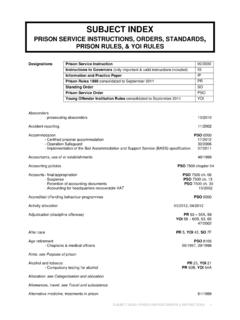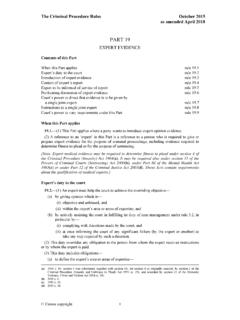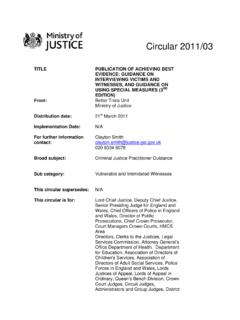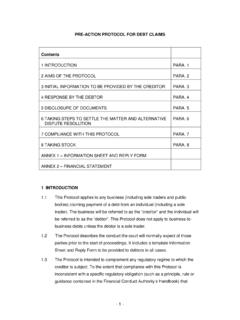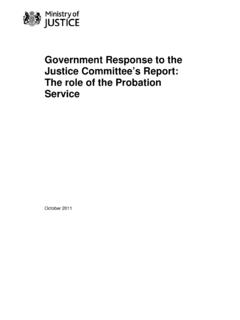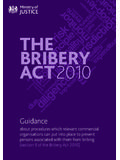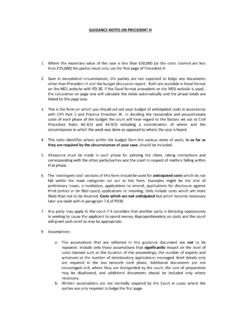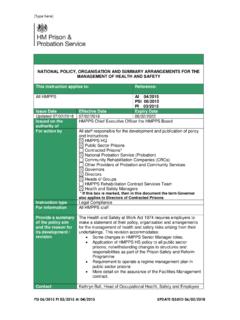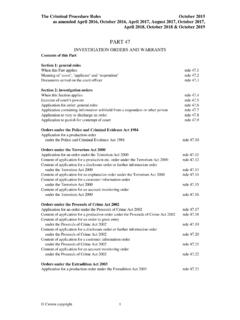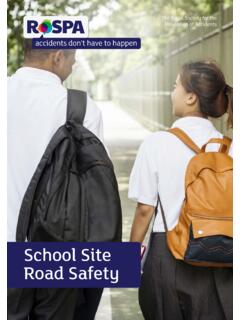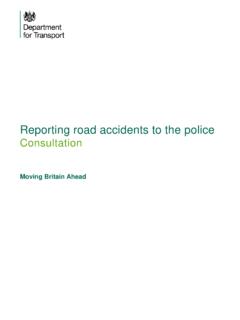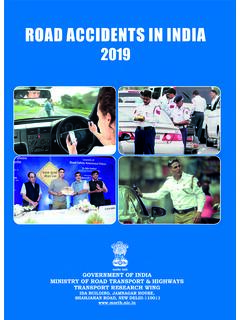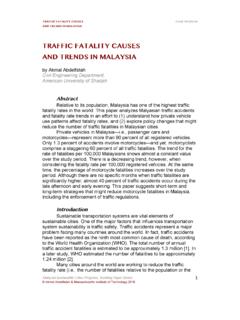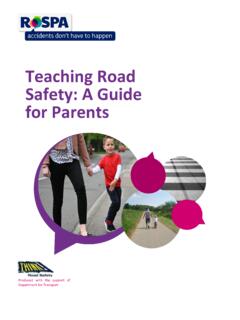Transcription of PRE-ACTION PROTOCOL FOR PERSONAL INJURY CLAIMS …
1 PRE-ACTION PROTOCOL FOR PERSONAL INJURY CLAIMS BELOW THE SMALL CLAIMS LIMIT IN road traffic ACCIDENTS PRE-ACTION PROTOCOL FOR LOW VALUE PERSONAL INJURY CLAIMS IN road traffic ACCIDENTS FROM 31ST JULY 2013 PRE-ACTION PROTOCOL FOR LOW VALUE PERSONAL INJURY (EMPLOYERS LIABILITY AND PUBLIC LIABILITY) CLAIMS PRE-ACTION PROTOCOL FOR PERSONAL INJURY CLAIMS The Master of the Rolls as Head of Civil Justice approves (a) the new PRE-ACTION PROTOCOL for PERSONAL INJURY CLAIMS Below the Small CLAIMS Limit in road traffic Accidents; and (b) the amendments to (i) the PRE-ACTION PROTOCOL for Low Value PERSONAL INJURY CLAIMS in road traffic Accidents From 31st July 2013; (ii) the PRE-ACTION PROTOCOL for Low Value PERSONAL INJURY (Employers Liability Public Liability) CLAIMS ; and (iii) the PRE-ACTION PROTOCOL for PERSONAL INJURY CLAIMS .
2 The new PRE-ACTION PROTOCOL and the amendments to the existing PRE-ACTION Protocols come into force on 31 May 2021. Signed by: The Right Honourable Sir Geoffrey Vos Master of the Rolls Date: 18th February 2021 PRE-ACTION PROTOCOL FOR PERSONAL INJURY CLAIMS BELOW THE SMALL CLAIMS LIMIT IN road traffic ACCIDENTS 1) The new PRE-ACTION PROTOCOL for PERSONAL INJURY CLAIMS Below the Small CLAIMS Limit in road traffic Accidents is set out in the Schedule to this Update. PRE-ACTION PROTOCOL FOR LOW VALUE PERSONAL INJURY CLAIMS IN road traffic accident 31ST JULY 2013 1) In the table of contents a) after the entry for paragraph , insert Whiplash injuries - children and protected parties ; and b) after the entry for paragraph , insert CLAIMS which consist of, or include, a claim for whiplash INJURY Medical Reports.
3 2) In paragraph a) after sub-paragraph (14), insert (14A) protected party means a person who lacks capacity to conduct court proceedings, as defined in rule (2); ; b) in sub-paragraph (16A), after secondary in significance to the physical INJURY , insert , but excludes any claim which consists of or includes a whiplash INJURY ; c) after sub-paragraph (16A), insert (16B) tariff and tariff amount means any tariff of damages for whiplash injuries and, if relevant, minor psychological injuries suffered on the same occasion as the whiplash injuries, set by the Whiplash INJURY Regulations 2021; d) in sub-paragraph (17), at the end, omit and ; e) after sub-paragraph, insert (17A) uplift means the amount greater than the tariff amount which the claimant may claim in defined exceptional circumstances as set out in the Whiplash INJURY Regulations 2021; ; f) in sub-paragraph (18), at the end, for.
4 , substitute ; ; g) after sub-paragraph (18), insert (19) vulnerable road user a road user is treated as vulnerable where, at the time the accident occurred, the claimant was (a) using a motor cycle; (b) a pillion passenger on, or a passenger in a sidecar attached to, a motor cycle; (c) using a wheelchair, a powered wheelchair or a mobility scooter; (d) using a bicycle or other pedal cycle; (e) riding a horse; or (f) a pedestrian; and vulnerable road user has that meaning in this PROTOCOL ; and (20) whiplash INJURY or whiplash injuries means an INJURY or injuries of soft tissue in the neck, back or shoulder suffered because of driver negligence as defined in section 1 of the Civil Liability Act 2018 and as further applied by section 3 of that Act to CLAIMS where the duration of the whiplash INJURY or any of the whiplash injuries (a) does not exceed, or is not likely to exceed, two years; or (b) would not have exceeded, or would not be likely to exceed, two years but for the claimant s failure to take reasonable steps to mitigate its effect.
5 3) In paragraph , in sub-paragraph (2), after PROTOCOL upper limit , omit the words , or between 1,000 and the PROTOCOL upper limit, . 4) In paragraph a) In sub-paragraph (1), for where the CNF is submitted on or after 31st July 2013 , substitute which occurs on or after 31st May 2021 ; b) after sub-paragraph (4), for the second set of words in parenthesis, substitute (Rule provides that, except where Rule applies, the small CLAIMS track is not the normal track where the claim has a financial value of more than 10,000 or where the value of any claim for damages for PERSONAL injuries (defined as compensation for pain, suffering and loss of amenity) is more than (a) 5,000 where the claim arises from a road accident as defined on or after 31st May 2021, except where (b) applies.
6 (b) 1,000 where the claim arises from a road accident where the accident occurred before 31st May 2021, or the claimant is a child, a vulnerable road user or where any of the other categories in rule applies. (As to the application of rule , see paragraph below.) Whiplash injuries children and protected parties (1) This PROTOCOL applies where the claim consists of or includes a claim for whiplash INJURY and (a) the claimant is a child; (b) the claim arises from a road traffic accident which occurs on or after 31st May 2021; and (c) the claim is worth no more than the PROTOCOL upper limit. (2) This PROTOCOL does not apply where the claimant is a protected party. (Rule provides that such a claim must not be allocated to the small CLAIMS track, even though the claim for whiplash INJURY may be valued at less than 1,000.)
7 5) In paragraph a) Immediately after the paragraph number, insert (1) The PRE-ACTION PROTOCOL for Low Value PERSONAL INJURY CLAIMS in road traffic Accidents which commenced on 31 July 2013 will continue to apply (as it stood immediately before 31 May 2021 to all CLAIMS where the accident occurred before 31 May 2021, except where paragraph (2) applies. ; and b) renumber the existing wording of this paragraph as sub-paragraph (2). 6) In paragraph (4), omit the words claimant or and as defined in rule (2) . 7) Omit paragraph 8) For paragraph , substitute (1) Where the claimant reasonably believes that the claim is valued at above the limit in paragraph (2) but at no more than the PROTOCOL upper limit, but it subsequently becomes apparent that the value of the claim is below the limit in paragraph (2), the claimant is entitled to the Stage 1 and (where relevant) the Stage 2 fixed costs.
8 (2) The limit referred to in paragraph (1) above is 5,000 for damages for PERSONAL INJURY and 10,000 in total and is limited to CLAIMS where the claimant is not a child. (1) Subject to paragraph (2), where a claim has started in the RTA Small CLAIMS PROTOCOL and the defendant has notified the claimant that they consider the overall claim is likely to be valued at more than 10,000 or the claim for damages for INJURY is likely to be valued at more than 5,000, this PROTOCOL should be applied starting at paragraph (2) Paragraph (1) applies only where (a) the defendant also notifies the claimant that they consider that the claim is worth no more than the PROTOCOL upper limit; (b) the claim is not one which was started in the RTA PROTOCOL and no longer continued in that PROTOCOL ; and (c) either (i) there was an admission of liability in full under this PROTOCOL within the response period.
9 (ii) there was an admission of liability in full but subject to an argument that the claimant contributed to their injuries by not wearing a seatbelt (where the claimant admitted not doing so); or (iii) the period for a liability response under this PROTOCOL has not yet expired.. 9) After paragraph , insert Where (a) paragraph (4)(b) applies; (b) the date of the accident is on or after 31st May 2021; and (c) the parties have agreed that the RTA Small CLAIMS PROTOCOL applies, the claimant must start a claim by following that PROTOCOL , starting at paragraph . 10) In paragraph , for The claimant to the end of that paragraph, substitute (1) Save where paragraph (2) applies, the clamant should obtain a medical report, if one has not already been obtained. (2) In CLAIMS which consist of or include a whiplash INJURY , the claimant must obtain a medical report in accordance with paragraph.
10 11) In paragraph , in the heading to that paragraph, for the words other than soft tissue INJURY CLAIMS , substitute (other than soft tissue INJURY CLAIMS or CLAIMS which consist of, or include, a claim for a whiplash INJURY . 12) After paragraph , insert CLAIMS which consist of, or include, a claim for whiplash INJURY Medical Reports (1) The provisions of paragraph and apply in respect of a medical report obtained under this paragraph, save that (a) any reference to soft tissue INJURY claim is to be read as referring to a claim which consists of, or includes, a claim for whiplash INJURY ; (b) paragraph (2) below applies in place of paragraph (2). (2) A further report, whether from the first expert instructed or from an expert in another discipline, will only be justified where (a) it is recommended in the first expert's report; (b) the first medical report recommends that further time is required before a prognosis of the claimant s injuries can be determined; (c) the claimant is receiving continuing treatment; or (d) the claimant has not recovered as expected in the original prognosis.
